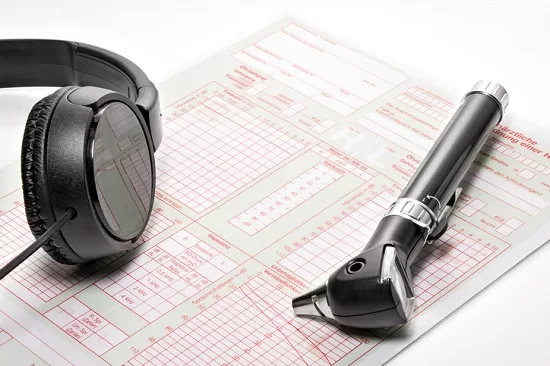The hearing exam truly is the easy part. The difficult part is accepting your hearing loss and actually booking the hearing test in the first place.
You’ve probably heard the stats by now: 48 million individuals in the United States have hearing loss but only a minor fraction actually do anything about it, and only 20 percent of those who could reap benefits from hearing aids actually wear them.
So if you’ve already arranged your hearing test, congratulations, you’ve already conquered the biggest barrier to better hearing.
The hearing test, as you’ll notice, is a simple and easy, non-invasive procedure that will determine the magnitude of your hearing loss to help establish the best suited treatment course.
After you first arrive at the office, you’ll begin by submitting some paperwork. Then, you’ll meet with your hearing care professional to review your hearing health history.
Your Hearing Health History
Your hearing loss, if present, can be triggered by exposure to loud sound, the normal aging process, or by an underlying condition. You’ll want to exclude any underlying medical conditions prior to proceeding to the actual hearing test.
If you have an earwax impaction, as an example, you could be hearing better within a few minutes after a professional cleaning. The existence of any other conditions will be assessed and the appropriate referral made, if required.
After analyzing your basic medical history, you’ll discuss your subjection to loud sounds, your hearing loss symptoms, and what you would like to accomplish with better hearing.
It’s very important to determine potential causes, how symptoms are adversely affective your life, and how better hearing will enhance your life, which is in the end the whole point. Be suspicious of the practitioner that doesn’t seem to care about the reasons why you desire to enhance your hearing in the first place.
Testing Your Hearing
There’s one additional step to take prior to starting the hearing test: the visual evaluation of the ear with a device known as an otoscope. This will help in ruling out any problems with the ear canal, the eardrum, or the excess accumulation of earwax.
Next, you’ll be escorted to a sound-treated room with your hearing care professional. You’ll be required to put on headphones, and the provider will begin to play you some sounds.
You will be presented with different sounds at multiple frequencies, and you’ll be asked to identify the quietest sounds you can hear at each pitch. This is called your hearing threshold, and the hearing care professional will document these values on a diagram known as an audiogram.
The hearing test will probably also entail speech testing, where you’ll be asked to repeat the words presented to you. Various types of words, presented at various volumes with and without background noise, will be presented. This will help establish if hearing aids can assist you with speech understanding.
At the conclusion of the testing, your hearing care professional will discuss the results with you.
Assessing Your Hearing Test Results
Referring to your audiogram, your hearing care provider will now discuss your hearing in both ears. Determined by the results, your hearing will be characterized as normal or as exhibiting mild, moderate, severe, or profound hearing loss.
If a hearing loss is found, the next step is discussing your treatment options. Seeing as there are no existing medical or surgical treatments to repair hearing damage, this means examining your hearing aid options.
Modern day hearing aids are available in a wide range of shapes, sizes, and colors, at different price points with several advanced features. In choosing your hearing aids, it’s essential to work with an experienced hearing care professional for three main reasons:
- They can help you identify the best hearing aid model to meet all of your objectives.
- They can help you determine the advanced features you need—as well as with the ones you don’t—at a price that suits your budget.
- They can program your new hearing aids to amplify only the sounds you have trouble hearing—identified by the hearing test—ensuring optimal sound quality.
And that’s it, a fast, easy procedure in exchange for a lifetime of healthier hearing. We’d say that’s a very good deal.
We look forward to seeing you!

